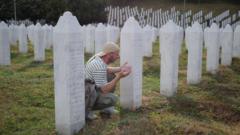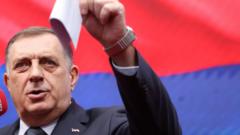The horror of mid-July 1995 still resonates deeply in Bosnia and Herzegovina, where remembrance of the Srebrenica massacre triggers both mourning and turmoil. During the recent world premiere of the play "Flowers of Srebrenica" at Sarajevo's War Theatre, powerful emotions erupted as performers mimicked the harrowing search for remains of victims.
In what is considered the most significant war crime in Europe since World War II, around 8,000 Bosnian men and boys lost their lives at Srebrenica. This event unfolded as Bosnian-Serb forces overwhelmed the area, where thousands of Bosniaks had sought refuge under the belief that the United Nations would protect them. Instead, the failing promise of safety led to one of Europe’s most tragic atrocities.
Following the massacre, footprints of grief have lingered, embodied in legislative controversies and social divisions. Bodies were hastily buried in mass graves, then exhumed and scattered across various sites, leaving families in a perpetual state of anguish as they searched for their loved ones. "Flowers of Srebrenica" illustrates this painful journey, drawing on the horrors of the past to highlight ongoing challenges.
In a somber acknowledgment, lead actress Selma Alispahić, a former refugee, expressed her despair at the lack of collective acknowledgement of the genocide. Despite international affirmations and convictions, including those against General Ratko Mladić and political leader Radovan Karadžić, denial persists, especially within the majority-Serb Republika Srpska.
The political landscape remains fraught. The Dayton Peace Agreement, which ended the Bosnian War four months post-massacre, has resulted in further ethnic segmentation. In recent months, Milorad Dodik, president of Republika Srpska, has laid plans to withdraw from national institutions, stoking tensions that many fear could lead to a regression of peace. His defiance against the international High Representative Christian Schmidt’s rulings has only deepened this crisis.
As commemorative events unfold in Sarajevo, the divide is stark—while many honor the victims, a contrasting sentiment prevails just outside the cityscape. In East Sarajevo, reflections of the genocide are glaringly absent. Some officials push the narrative that all ethnic communities experienced victimhood, failing to confront the unique horror of Srebrenica itself.
Mirela Osmanović, a staff member at the Srebrenica Memorial Centre, describes heightened anxiety among those returning to their ancestral homes. The oppressive climate fostered by local leaders raises fears for the safety and future well-being of many Bosniaks. D juxtaposed with the celebration of reconciliation includes activities that promote solidarity, with civilians feeling a pressing desire to honor those lost at Srebrenica.
The cycle of heightened ethnic tension is tangled in political machinations, often leaving victims' families grappling with continual grief and a lack of closure. For many in Srebrenica, the path toward healing remains obstructed amid the echoes of the past intertwined with the dangers of today’s evolving political landscape.






